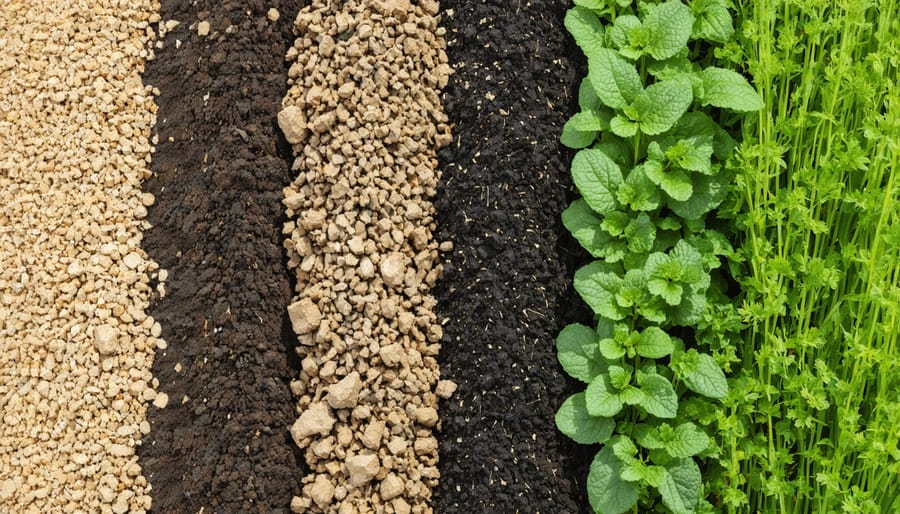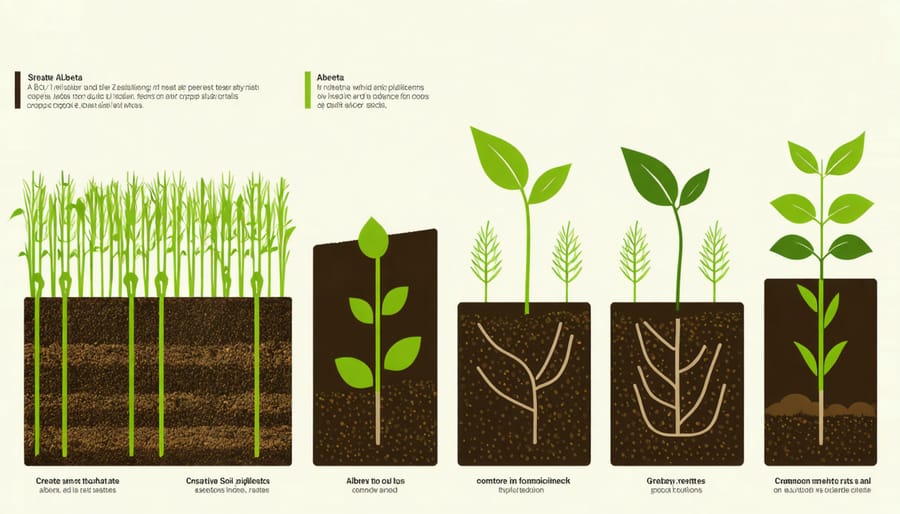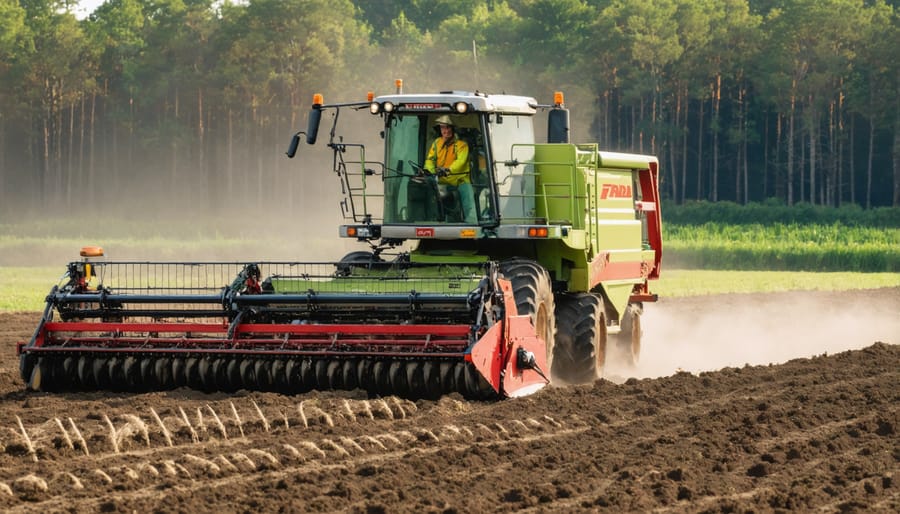Transform your farm’s productivity by mastering the 4 R’s of nutrient management: Right Source, Right Rate, Right Time, and Right Place. These nutrient cycling principles form the cornerstone of sustainable agriculture across Alberta’s diverse growing regions. Precision in nutrient application not only maximizes crop yields but also protects our soil and water resources while reducing input costs by up to 30%. Whether managing a small organic operation or a large-scale farm, implementing these four principles helps build resilient agricultural systems that maintain productivity through challenging growing seasons. Canadian farmers who adopt these strategies consistently report improved soil health, reduced environmental impact, and stronger profit margins – essential outcomes for today’s agricultural landscape.
Right Source: Choosing Organic Nutrient Sources
Local Organic Matter Sources
Alberta farmers have access to diverse local sources of organic nutrients that can enhance their organic matter management practices. Livestock manure remains a primary resource, with cattle operations throughout the province providing valuable nutrients. Properly composted manure offers balanced nutrition and improved soil structure while reducing the risk of weed seeds and pathogens.
Green manure crops, particularly legumes like field peas and red clover, are well-suited to Alberta’s growing conditions and can fix significant amounts of nitrogen while adding organic matter to the soil. These crops can be effectively integrated into rotation schedules between main cash crops.
Local food processors and municipalities often provide compost derived from food waste and yard trimmings. These materials are particularly valuable in areas near urban centers like Edmonton and Calgary. Additionally, many Alberta grain farmers have access to crop residues such as straw and chaff, which can be incorporated directly into the soil or composted first.
Forest products, including sawdust and bark mulch from Alberta’s forestry industry, serve as excellent carbon sources when balanced with nitrogen-rich materials. Some innovative farmers have also established partnerships with nearby mushroom operations to utilize spent mushroom substrate, which is rich in nutrients and beneficial microorganisms.

Quality Assessment of Organic Inputs
When using organic nutrient sources, proper quality assessment is crucial for successful nutrient management. Start by examining the source material’s physical characteristics – it should be free from contaminants, have a consistent texture, and emit an earthy odour. For compost, look for a dark, crumbly consistency with no traces of undecomposed materials.
Always request laboratory analysis reports from suppliers, which should detail nutrient content, organic matter percentage, and potential contaminants. Key nutrients to look for include nitrogen (N), phosphorus (P), and potassium (K), along with secondary nutrients and micronutrients. For Alberta farmers, testing labs like the Agriculture and Food Laboratory offer comprehensive analysis services.
Consider the C:N ratio of organic materials, as this affects nutrient release timing. Mature compost typically has a C:N ratio between 10:1 and 20:1, ideal for most farming applications. Keep detailed records of analysis results and supplier information for future reference.
Watch for signs of poor quality, such as excessive moisture, strong ammonia smell, or visible contamination. Local agricultural extension offices can provide guidance on quality standards and testing procedures specific to your region.
Remember that organic nutrient sources vary naturally in their composition. Regular testing and assessment help ensure consistent application rates and optimal crop response. Building relationships with reliable suppliers who understand your farm’s needs can help maintain input quality over time.
Right Rate: Calculating Optimal Application

Soil Testing and Analysis
Regular soil testing forms the foundation of effective nutrient management in Alberta’s diverse agricultural landscape. By understanding your soil’s composition through professional analysis, you can make informed decisions about implementing proven soil health solutions that work for your specific conditions.
In Alberta’s varying climate zones, from the Peace Country to the southern prairies, soil testing should be conducted at least every two to three years, with more frequent testing recommended for intensive cropping systems. A comprehensive soil analysis provides crucial data about nutrient levels, pH, organic matter content, and soil texture – all essential factors in determining appropriate fertilizer applications.
For best results, collect soil samples in early spring or late fall when the ground is workable. Take multiple samples from different field zones, considering variations in topography, soil color, and crop performance. Each sample should represent the root zone depth, typically 0-15 cm for most annual crops and 0-30 cm for deeper-rooted crops.
Local agricultural labs across Alberta offer specialized testing services that consider regional soil characteristics. These results help you develop a targeted nutrient management plan that optimizes input costs while maintaining soil health and promoting sustainable crop production. Remember to keep detailed records of your soil test results to track changes over time and adjust your management strategies accordingly.
Crop-Specific Requirements
Different crops in Alberta have varying nutrient requirements throughout their growing cycles. For wheat and barley, nitrogen is particularly crucial during the tillering and stem elongation stages, with typical requirements ranging from 90-120 kg/ha depending on yield targets. Canola, another major Alberta crop, needs higher amounts of sulfur compared to cereals, typically requiring 20-30 kg/ha for optimal growth.
Pulse crops like peas and lentils have unique nutrient profiles due to their nitrogen-fixing abilities. While they need minimal nitrogen fertilization, they often require adequate phosphorus (20-30 kg/ha) and potassium for proper nodulation and growth. These crops also benefit from starter nitrogen applications of 5-10 kg/ha in cold soils.
For potato growers in southern Alberta, split applications of nitrogen throughout the season help match nutrient availability with crop demand. Typical total nitrogen requirements range from 180-220 kg/ha, with phosphorus needs around 80-100 kg/ha.
Timing is critical across all crops. Spring soil testing helps determine baseline nutrient levels, while in-season tissue testing can guide supplemental applications. Consider that sandy soils typically require more frequent applications of mobile nutrients like nitrogen, while heavy clay soils might need less frequent but higher phosphorus applications due to fixation issues.
Remember that these requirements serve as general guidelines and should be adjusted based on soil tests, previous crops, and specific field conditions.
Right Time: Timing Your Applications
Seasonal Considerations
In Alberta’s distinct climate, timing your nutrient management activities is crucial for maximizing effectiveness. Our growing season typically runs from May to September, with significant variations across the province’s diverse agricultural zones.
Spring applications should align with soil temperatures reaching above 5°C, usually in late April to early May. This timing ensures nutrients are available when crops begin their active growth phase. However, be mindful of spring runoff risks – waiting until fields are properly dried prevents nutrient loss and soil compaction.
Summer presents opportunities for in-season adjustments through foliar applications and side-dressing, particularly during critical growth stages. For most crops, the highest nutrient demand occurs during the vegetative and early reproductive stages.
Fall applications require careful consideration of soil temperature and moisture conditions. Apply nutrients when soil temperatures fall below 10°C to minimize losses through volatilization, typically from late September to early October. This allows time for proper incorporation before freeze-up while reducing the risk of nutrient leaching.
Winter applications should be avoided due to frozen ground conditions and increased risk of spring runoff. Instead, use this time for planning next season’s nutrient strategy based on soil test results and previous year’s observations.
Remember that weather patterns can vary significantly across Alberta’s regions, so adjust these general timing guidelines according to your local conditions and specific crop requirements.
Crop Growth Stages
Understanding crop growth stages is crucial for timing nutrient applications effectively. Different crops have varying nutrient demands throughout their growth cycle, and matching nutrient availability with these demands maximizes uptake efficiency while minimizing losses.
For cereal crops like wheat and barley, common in Alberta, the highest nutrient demands occur during the tillering and stem elongation phases. These stages typically require significant nitrogen and phosphorus to support rapid growth. During heading and grain filling, potassium and micronutrients become increasingly important for yield quality.
Pulse crops, such as peas and lentils, have different nutrient timing needs. While they fix their own nitrogen, they require early-season phosphorus and potassium to establish strong root systems. Peak nutrient uptake occurs during flowering and pod formation stages.
Local farmer Dave Thompson from Lacombe County shares, “I’ve learned to split my nutrient applications based on growth stages. Early-season starter fertilizer helps with emergence, while in-season applications support the heavy feeding periods.”
To properly match nutrients with crop demands:
– Monitor crop development regularly
– Use soil testing to understand nutrient availability
– Consider weather conditions when planning applications
– Adjust timing based on crop type and variety
– Document application timing and crop response for future reference
Remember that environmental factors like soil temperature and moisture levels affect nutrient availability and should influence your application timing decisions.
Right Place: Optimal Placement Methods
Application Techniques
In organic farming systems, successful nutrient management relies heavily on timing and precision. For Alberta farmers, spring application of composted manure typically works best, allowing nutrients to become available as crops enter their growth phase. Spreading should occur when soil temperatures reach at least 10°C to maximize microbial activity and nutrient cycling.
Consider using cover crops like legumes to fix nitrogen naturally and build soil organic matter. Red clover and field peas are particularly well-suited to Alberta’s climate and can contribute up to 100 kg of nitrogen per hectare when properly managed.
Variable rate technology (VRT) can be adapted for organic systems by creating detailed soil maps and applying organic amendments accordingly. Many Alberta farmers use GPS-guided equipment to ensure even distribution of compost and other organic materials.
For precision application, consider split applications of organic fertilizers, especially for demanding crops like corn or wheat. This approach helps match nutrient availability with crop demand throughout the growing season.
Foliar applications of approved organic nutrients can provide a quick boost during critical growth stages. Seaweed extracts and compost teas are popular options, best applied early morning or late evening when leaves are most receptive.
Monitor soil moisture levels before application, as organic nutrients require adequate water for proper breakdown and uptake. In drier areas of Alberta, timing applications before forecasted rain can improve nutrient availability and reduce the risk of volatilization.
Soil incorporation Strategies
Effective nutrient incorporation into soil requires careful planning and precise execution to maximize uptake and minimize losses. Alberta farmers have seen remarkable success with proven soil management practices that enhance nutrient availability while protecting soil structure.
For granular fertilizers, incorporate nutrients at a depth of 5-10 cm, where root activity is highest. This placement helps protect nutrients from surface runoff while keeping them accessible to growing plants. Using strip-till or banding techniques can reduce soil disturbance while ensuring precise nutrient placement.
Liquid fertilizers benefit from injection systems that place nutrients directly into the root zone. For spring applications, consider using GPS-guided equipment to maintain consistent application patterns and avoid overlap. When incorporating organic amendments like manure or compost, timing is crucial – fall application allows for better decomposition and nutrient release by spring planting.
Conservation tillage practices work well for many Alberta farmers, as they maintain soil moisture and organic matter while incorporating nutrients. For sensitive areas near water bodies, establish buffer zones of at least 30 metres to prevent nutrient migration. Regular soil testing helps monitor nutrient levels and adjust incorporation strategies accordingly.
Remember to consider soil temperature and moisture conditions during application – ideal incorporation occurs when soil is neither too wet nor too dry, typically at field capacity.

The integration of the 4 R’s – Right Source, Right Rate, Right Time, and Right Place – offers Alberta farmers a robust framework for sustainable nutrient management in organic farming systems. By implementing these principles together, farmers can maximize their crop yields while maintaining soil health and environmental stewardship.
Many Alberta farmers have reported significant improvements in both soil quality and crop performance after adopting this holistic approach. For example, organic grain producers in central Alberta have seen up to 15% increase in yields when carefully timing their composted manure applications and selecting appropriate nutrient sources for their specific soil conditions.
The 4 R’s framework aligns perfectly with organic farming principles, supporting natural soil biology and reducing dependency on external inputs. This approach helps farmers build resilient farming systems that can better withstand climate variability while meeting the growing demand for organic products in Canadian markets.
Looking ahead, the adoption of these practices positions Alberta farmers at the forefront of sustainable agriculture. The combination of traditional farming wisdom with modern nutrient management strategies creates a powerful toolkit for future generations. By embracing these principles, farmers can enhance their farm’s productivity, protect environmental resources, and contribute to the long-term sustainability of Alberta’s agricultural sector.
Remember, successful implementation of the 4 R’s is an ongoing journey of learning and adaptation. Local agricultural extension services and farmer networks provide valuable support for those transitioning to this management approach.











